The Age of Fesarius
On November 10th 1966 “The Corbomite Maneuver” first aired on NBC television as Star Trek’s 10th episode. It had actually been the first filmed episode of regular series production, and sort of an unofficial “third pilot” for the show. But the large number of optical effects required for the Enterprise, the cube buoy, phasers, explosion, the First Federation flagship Fesarius and its tiny pilot vessel forced a protracted post-production process which delayed the episode well into the season.
W T F[esarius]
The name “Fesarius” appears to have been wholly fabricated, and is right there from the beginning in Jerry Sohl’s first story outline for the episode—titled “Danger Zone”—where the ship is described as…
A long and sleek ship[...]with faintly blinking lights[…]more than two million tons, a mile long and a quarter mile high.
In two subsequent outlines, which bear the final title “The Corbomite Maneuver”, the Fesarius is described more familiarly…[1]
in the shape of a cluster of grapes, or fish eggs, or lead shot […] Some of the cell-like sections pulse with light.”
The final miniature and lighting evoke this.
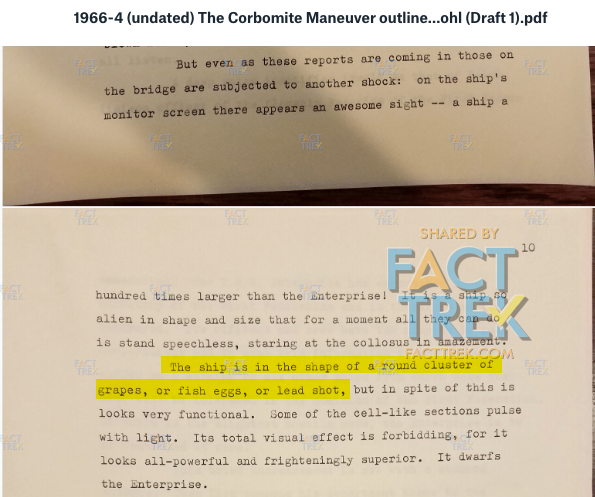
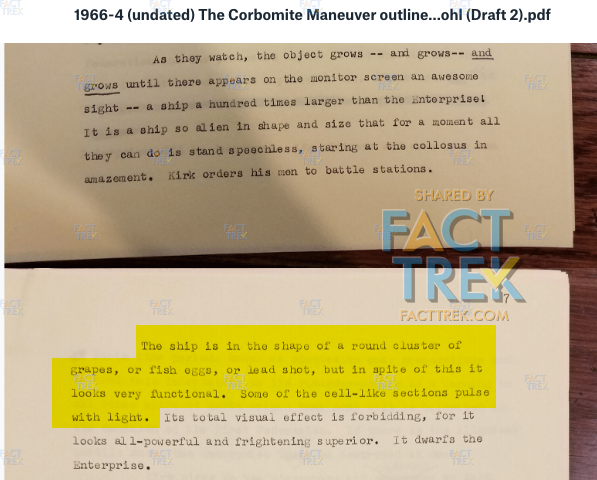

The Fesarius in Miniature
There’s almost no extant documentation about the miniatures built for this episode. According to the website Herocomm both ships and the buoy were built by Wah Ming Chang.[2] (We’re unable to independently confirm this due to Covid-19 preventing our usual access to archival materials, but Chang did build the Balok puppet for the episode, as well as other miniatures, so it’s at least plausible.)
It’s been claimed that the Fesarius surface was made with "ping-pong balls.” This goes back at least as far as Richard G. Van Treuren’s article “Star Trek Miniatures: The Other Space Ships” published in the book Best of Trek (1978): [3]
As called for in "The Corbomite Maneuver,"' the First Federation Flagship Fesarius would be too important to pass off. A miniature said to have been made of Ping-Pong balls and the like was created, achieving an excellent vague and indefinite appearance.
But Treuren had previously written a piece titled “Miniature Star Trek” in the fanzine T-Negative #18, October 1972, which may have been the basis of that.[4][5]
Now, notice that Treuren says only that “A miniature said to have been made of Ping-Pong balls and the like was created,” but not that this was the flagship. He could have meant the smaller pilot vessel. From the text alone there’s no way of knowing.
In either case, thanks to our friends who did the spectacular book Star Trek Lost Scenes we have the amazing photo of the Fesarius miniature seen in this piece. For the finished episode the miniature photography appears to have been tinted yellowish in post, giving the grey surface a greenish tinge. Below is the untinted original color.
Looking at this restored photo it’s abundantly clear the Fesarius surface is not in any way composed of ping pong balls, sliced, diced, or inserted from the back. They’re low domes, but just what are they made of? Possibly large acrylic dome shank buttons with smaller more golden ones at junctions. It could also be some sort of pre-made material or costume jewelry. Speculation, yes, but clearly not ping-pong balls (if it were, why would anyone shave them so thin?).
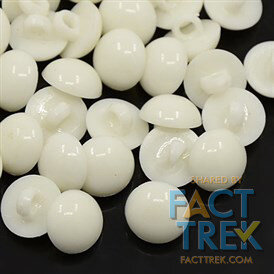
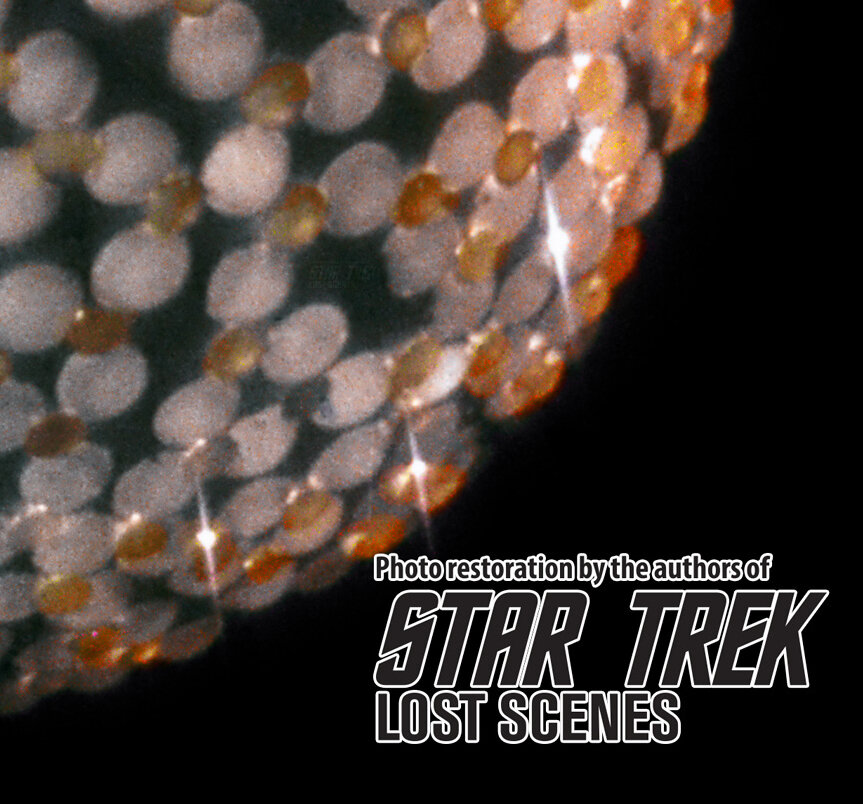
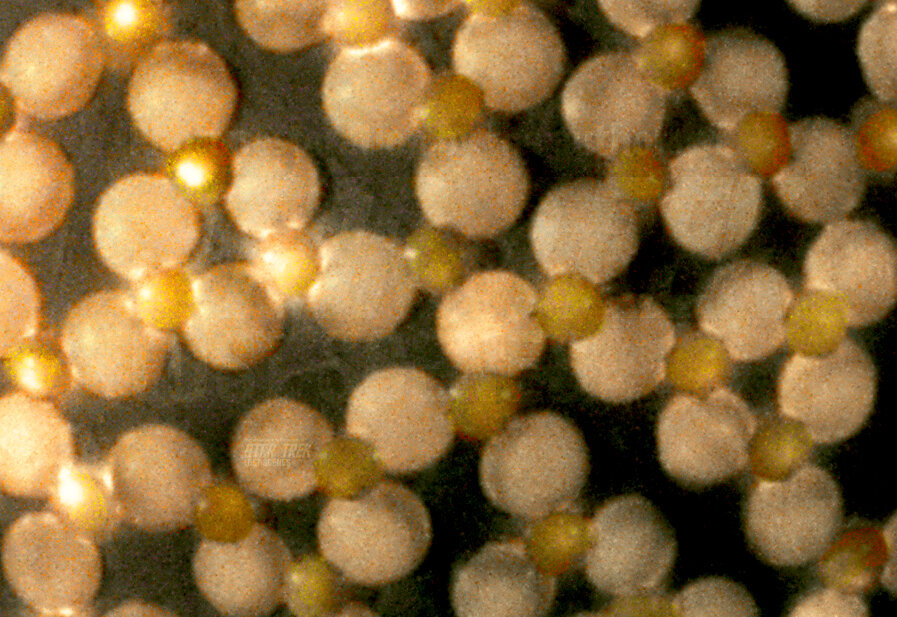
Note that there are either small bulbs or holes beneath the latter small domes, emitting light. The white domes may have been lit externally as the hull surface brightens with them. If you look closely you can see seams between triangles on the grey surface hemisphere this texture was mounted on. This underlying surface could have been a found object, or a plexiglass dome with lines added. Either way, we’re pretty sure the model was a half sphere with no back, because you can see how the texture ends rather abruptly at the horizon.
Back to the ping pong story and if it might apply to the main spheres of Balok’s smaller scout ship, we can’t say either way. The scout is effectively seen from a single angle in every shot it appears in, so it’s difficult to assess its possible construction. It may have been made from the same domes seen on the Fesarius surface... or maybe those pesky ping pong balls. The mystery remains.
The Manchild Behind the Curtain
Now let's have a quick look at faux antagonist Balok. First seen as a distorted image of a threatening alien effigy sculpted by the masterful Wah Min Chang before finally being revealed as a diminutive literal “man behind the curtain” performed by the inimitable Clint Howard, then age seven.[6] There was some concern about how to portray the small alien, and that a little person like Michael Dunn would be too well known to the audience, leading ultimately to the casting of a child in the role.
Wah Min Chang’s concept drawing for the Balok effigy (Note he has ears here).[7]
The part should be played by a midget or a dwarf. There aren't many actors with these physical characteristics who could handle the job. And certainly the few that are available are rather well known to our audience.[8]
To make him look aged Howard was given bushy eyebrows and wore a bald cap. The obvious makeup seams doubtless contributed to the decision to give him some headgear, concepts for which are drawn on two of four surviving makeup test photos we found.[9]
In Conclusion
So raise a glass of Tranya for this brief anniversary look at Star Trek’s first series-production episode, "The Corbomite Maneuver".
We hope you relish it as much as we did!
— 30 —
Acknowledgements
GREAT THANKS to our friends David Tilotta & Curt McAloney for providing these beautifully restored photos of Balok’s ride. And for more amazing behind-the-scenes glimpses of the making of Star Trek check out their amazing book STAR TREK LOST SCENES and then buy it! (link)
End Notes & Sources
[1] UCLA, The Gene Roddenberry Star Trek Television Series Collection (1964-1969). Specifically:
“Danger Zone” story outline by Jerry Sohl
“The Corbomite Maneuver” first draft story outline by Jerry Sohl
“The Corbomite Maneuver” second draft story outline by Jerry Sohl
[2] The Creator's Story - Wah Ming Chang, Part 2 on HeroComm. (link)
It mentions “This comprehensive list of his services to Star Trek comes from the purchase orders on file with UCLA archives.” As per the article, due to the pandemic we cannot independently confirm this claim at this time.
Note also that the article’s other sources re Chang’s involvement in Star Trek are listed as a StarTrek.com article on Wah Chang (link) and Wikipedia article on Chang (link) (cringe), both of which mention only the Balok effigy and make no mention of the “Corbomite” miniatures.
[3] Star Trek Miniatures: The Other Space Ships” by Richard G. Van Treuren (link), Best of Trek (1978), edited by Walter Irwin and G. B. Love.
[4] Table of contents for The Best of Trek 1 - April 1978 (256) on the Fanlore.org wiki. (link)
[5] “Miniature Star Trek, an article miniatures by Richard Van Treuren” as listed in the contents for the fanzine T-Negative #18, October 1972 (link) as per the Fanlore.org wiki.
[6] Clint Howard on the Internet Movie Database (link)
[7] Wah Chang sketch of Balok, The Star Trek Sketchbook, The Original Series, by Herbert F. Solow and Yvonne Fern Solow, Pocket Books, 1997, p244. ISBN:9780671002190, 0671002198
[8] 1966-4-21 memo from Bob Justman to John D.F. Black, subject: 1st Draft script “The Corbomite Maneuver” by Jerry Sohl. The Gene Roddenberry Star Trek Television Series Collection (1964-1969).
[9] Undated, 1966 makeup test photos of Clint Howard (4 photos). The Gene Roddenberry Star Trek Television Series Collection (1964-1969).
FACT TREK COMMENT: Such tests were usually shot during an episode’s preparation week. As “Corbomite” began filming on May 24, 1966, we can assume these photos were taken in the range of May 17—23, 1966, but being this was the first series production episode, it might have been a bit earlier.










